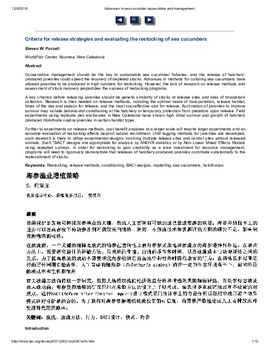Criteria for release strategies and evaluating the restocking of sea cucumbers

Citation
Purcell, S.W (2004). Criteria for release strategies and evaluating the restocking of sea cucumbers. FAO Fish. Tech. Pap. (463): 181-191
Conservative management should be the key to sustainable sea cucumber fisheries, and the release of hatchery-produced juveniles could speed the recovery of depleted stocks. Advances in methods for culturing sea cucumbers have allowed juveniles to be produced in high numbers for restocking. However, the lack of research on release methods and assessment of stock recovery jeopardizes the success of restocking programs. A key criterion before releasing juveniles should be genetic similarity of stocks at release sites and sites of broodstock collection. Research is then needed on release methods, including the optimal mode of transportation, release habitat, times of the day and season for release, and the most cost-effective size for release. Acclimation of juveniles to improve survival may include behavioural conditioning at the hatchery or temporary protection from predators upon release. Field experiments using replicate pen enclosures in New Caledonia have shown high initial survival and growth of hatchery produced Holothuria scabra juveniles in certain habitat types. Further to experiments on release methods, cost-benefit analyses at a larger scale will require larger experiments and an accurate evaluation of restocking effects beyond natural recruitment. Until tagging methods for juveniles are developed, such research is likely to utilise experimental designs involving multiple release sites and control sites without released animals. Such “BACI” designs are appropriate for analysis by ANOVA statistics or by Non-Linear Mixed Effects Models using repeated surveys. In order for restocking to gain credibility as a wise investment for resource management, programs will need to rigorously demonstrate that releases of hatchery-produced juveniles contribute substantially to the replenishment of stocks.
Permalink
Date Available
Type
Publisher
Copyright
CC BY 4.0
Research Themes
Topics
Language